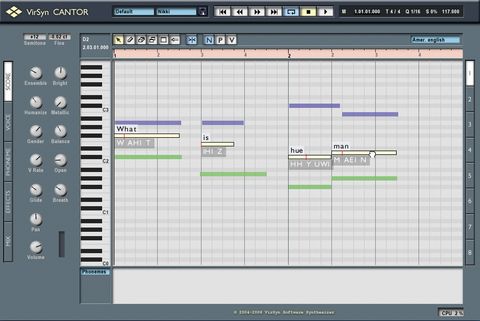VirSyn burst onto the plug-in scene several years ago with Tera, their superb semi-modular synth.
This combined analogue synthesis with FM, additive and modelling techniques. Next was Cube, an advanced additive instrument that brought a once-befuddling technology to our desktops in an easy-to-understand package.
Then came Cantor, VirSyn's 'singing synthesizer'. This featured some of the technologies used in Cube but was a wholly new type of instrument that promised to give electronic musicians the ability to create vocal parts via a piano roll-style interface.
Like many groundbreaking instruments, Cantor was perhaps slightly misunderstood. Those who expected to be able to push a few buttons and then suddenly have a top-quality session vocalist bursting from their speakers were left disappointed.
It was undeniably innovative, but the results sounded more like they'd come from the mouths of Daleks than Dean Martin. We certainly struggled with it. As hard as we tried, our Cantor projects sounded little better than a Cylon with toothache.
The biggest problem with the first version of the software was its GUI. While the piano roll was familiar enough, arranging syllables and phonemes across a grid produced sterile, static sounds that only vaguely resembled singing.
Fortunately, the new and updated Cantor is far easier to get to grips with. A variety of improvements have been made to the interface and also to the intelligibility and level of realism.
What should be said, however, is that Cantor 2 is most emphatically not being sold as a substitute for a real singer, so if you approach it in the hope that it is, you'll undoubtedly be frustrated. If you adjust your expectations, though, you may find a formidable ally.
In use
Initially, Cantor 2 seems identical to its predecessor. The Score page still looks like a piano roll, and alternative pages are accessed via tabs along the left-hand side.
Notes are drawn into the score in the usual fashion, and syllables and words are typed above the horizontal blocks that represent each note. Once typed, phonetic representations of the words are shown beneath them.
You get the same allotment of tools as before (selection, pencil and erase tools are all available) but the Score page contains a couple of very important additions in the form of pitch and volume buttons. Clicking on these reveals fully flexible envelopes that can be manipulated to produce realistic vibrato and dynamic changes.
We can't overemphasise the significance of these additions: the pitch envelope enables you to easily and intuitively create both subtle pitch fluctuations and the sweeping, bent notes that are typical of good vocal performances, while volume envelopes allow you to create dynamic expression.
Once you've entered your notes and lyrics, they can be played back via standard transport controls. You can select the tempo and make basic changes to the vocal timbre right from the Score page, while gender, glide time, breath and other options can also be adjusted.
To get deep into the sound design side of things, though, you need to access the Voice page. Anyone who's used VirSyn's Cube will be at home with the Voice page, which comprises of two windows and an array of knobs. You can manipulate the frequency spectrum by drawing in the partials and also adjust the breath by working with the noise graph.
This amounts to a considerable level of control, but we have to say that the results can be a bit hit and miss. However, this isn't through any fault of the program itself: the trouble is that it's inherently difficult to design a voice from the ground up - most of us simply don't have the knowledge or patience for it.
Luckily, VirSyn have included a good number of prefab voices that can be adjusted to taste. When you do have a sound you like, you can add effects, adjust the formant filters and mix up to eight 'singers' to create ensemble performances. In fact, we feel that Cantor 2 actually works best with a few harmonising voices; it'll never sound like Crosby, Stills and Nash, but the results are interesting nonetheless.
Summary
Although it's improved, Cantor is still a work in progress. You have to remember that the technology behind it is still very new, but it certainly holds a lot of promise.
Even now, it can create some intriguing passages. That said, the software isn't for everyone, as the vocals produced are decidedly and unashamedly electronic.
To be honest, we doubt Cantor will ever sound exactly like a human vocalist, and we're not totally sure that it should do.
As an electronic instrument, it's much better thought of as a creative tool that can provide adventurous composers with some inspiration - it certainly provided the odd spark when we were testing it. If that's what you're after, give it a go.


